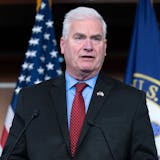WASHINGTON -- Is anyone out there still listening?
The digital age is killing AM radio, an American institution that brought the nation fireside chats, Casey Kasem's Top 40 and scratchy broadcasts of the World Series. Long surpassed by FM and more recently cast aside by satellite radio and Pandora, AM is now under siege from a new threat: rising interference from smartphones and consumer electronics that reduce many AM stations to little more than static. Its audience has sunk to historic lows. But at least one man in Washington is tuning in.
Ajit Pai, the lone Republican on the Federal Communications Commission, is on a personal if quixotic quest to save AM. After a little more than a year in the job, he is urging the FCC to undertake an overhaul of AM radio, which he calls "the audible core of our national culture." He sees AM — largely local news, sports, conservative talk and religious broadcasters — as vital in emergencies and in rural areas.
"AM radio is localism, it is community," said Pai, 40. AM's longer wavelength means it can be heard at far greater distances and so in crises, he said.
"When the power goes out, when you can't get a good cell signal, when the Internet goes down, people turn to battery-powered AM radios to get the information they need," Pai said.
He admits to feelings of nostalgia, growing up in small-town Parsons, Kan. On boyhood family road trips across the wide Kansas plains, he said, AM radio "was a constant companion."
But that was then. In 1978, when Pai was 5, half of all radio listening was on the AM dial. By 2011 AM listenership had fallen to 15 percent, or an average of 3.1 million people, according to a survey by Veronis Suhler Stevenson, a private investment firm. While the number of FM listeners has declined, too, they still averaged 18 million in 2011.
Although five of the top 10 radio stations in the country, as measured by advertising dollars, are AM — among them WCBS in New York and KFI in Los Angeles — the wealth drops rapidly after that. In 1970 AM accounted for 63 percent of broadcast radio stations, but now it accounts for 21 percent, or 4,900 outlets, according to Arbitron. FM accounts for 44 percent, or 10,200 stations. About 35 percent of stations stream content online.



